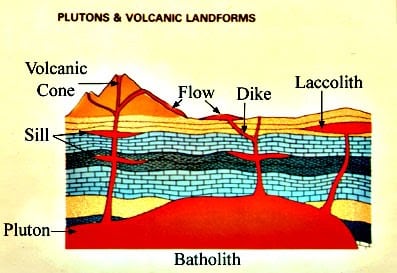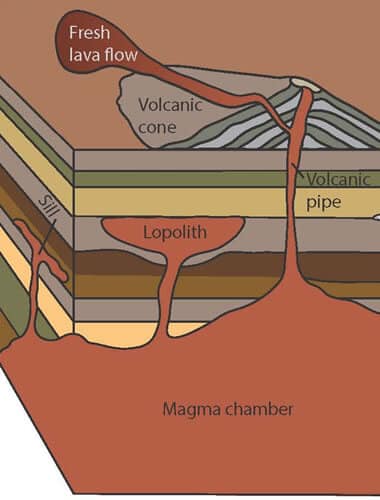Volcanism:
- Volcanism is the eruption of molten rock from inside the Earth to the surface. Volcanism occurs because of Earth’s internal heat, and is associated with tectonic processes and a part of the rock cycle.
- Volcanic eruptions occur when molten lava reaches the surface of the Earth.
- On Earth, volcanoes are most often found where tectonic plates are diverging or converging, and most are found underwater.
Types of Volcanic Eruptions
Types of volcanic eruptions depend on various factors such as chemistry of magma, temperature, viscosity, volume, presence of groundwater, and water and gas content.
Following are the different types of volcanic eruptions:
- Hydrothermal eruption: These eruptions include ash and not magma. They are driven by the heat caused in hydrothermal systems.
- Phreatic eruption: This is driven when the heat of the magma interacts with the water. These eruptions to do not include magma and only ash.
- Phreatomagmatic eruption: This eruption takes place when there is the interaction between the newly formed magma and water.
- Strombolian and Hawaiian eruption: Hawaiian eruption has fire fountains while the Strombolian eruption has explosions due to lava fragments.
- Vulcanian eruption: These eruptions last for a short period of time and can reach up to a height of 20 km.
- Subplinian and Phinian eruptions: Subplinian eruptions reach up to 20 km height, while Plinian eruptions reach up to 20-35 km.

Types of Volcanoes
Volcanoes are grouped into four types:
- Cinder cones
- Composite volcanoes
- Shield volcanoes
- Lava volcanoes
Cinder Cones
- Cinder cones are circular or oval cones made up of small fragments of lava from a single vent that have been blown up. Cinder cones result from eruptions of mostly small pieces of scoria and pyroclastics that build up around the vent.
- Most cinder cones erupt only once. Cinder cones may form as flank vents on larger volcanoes, or occur on their own.
Composite Volcano
- Composite volcanoes are steep-sided volcanoes composed of many layers of volcanic rocks, usually made from high-viscosity lava, ash and rock debris. These types of volcanoes are tall conical mountains composed of lava flows and other ejecta in alternate layers, the strata that give rise to the name.
- Composite volcanoes are made of cinders, ash, and lava. Cinders and ash pile on top of each other, lava flows on top of the ash, where it cools and hardens, and then the process repeats.
Shield Volcano
- Shield volcanoes are volcanoes shaped like a bowl or shield in the middle with long gentle slopes made by basaltic lava flows. These are formed by the eruption of low-viscosity lava that can flow a great distance from a vent.
- They generally do not explode catastrophically. Since low-viscosity magma is typically low in silica, shield volcanoes are more common in oceanic than continental settings. The Hawaiian volcanic chain is a series of shield cones, and they are common in Iceland, as well.
Lava Domes
- Lava domes are formed when erupting lava is too thick to flow and makes a steep-sided mound as the lava piles up near the volcanic vent. They are built by slow eruptions of highly viscous lava.
- They are sometimes formed within the crater of a previous volcanic eruption. Like a composite volcano, they can produce violent, explosive eruptions, but their lava generally does not flow far from the originating vent.
Categories of Volcanoes
- Active volcanoes: An active volcano is a volcano which is either erupting or is likely to erupt in the future. There are about 600 active volcanoes in the world, most of them being around the pacific “ring of fire”.
- The Stromboli volcano erupts so much fire that it has been termed as the lighthouse of the Mediterranean.
- Dormant volcano: A dormant volcano is one that is not currently erupting but has erupted within recordable history and is expected to erupt again in the future.
- Mt Kilimanjaro is one such volcano.
- Extinct volcano: Extinct volcanoes are considered dead and are not expected to ever erupt again.
- Aconcagua of Andes is a typical example of an extinct volcano.
Volcanic Mountains
Volcanic mountains are formed as a result of volcanic activities on the surface of the Earth. The magma inside the Earth erupts out as lava through the cracks on the Earth’s surface. This cools down repeatedly to form volcanic mountains.
Example:
- Mt. Kilimanjaro(Tanzania)
- Mt. Fuji (Japan)
- Mt. Merapi (Sumatra)
- Mt. Mayon (Philippines)
- Mt. Agung (Bali)
- Mt. Cotopaxi (Ecuador)

Volcanic Landforms
Intrusive Forms
- The lava that is discharged during volcanic eruptions on cooling develops into igneous rocks.
- The cooling may take place either on arriving on the surface or also while the lava is still in the crustal portion.
- According to the location of the cooling of the lava, igneous rocks are categorized as plutonic rocks and volcanic rocks.
- The lava that cools inside the crustal portions takes diverse forms. These forms are called intrusive forms.


Extrusive landforms – Magmas that reach the surface and solidify, form extrusive landforms.

Rocks formed by either plutonic or volcanic activity are called igneous rocks.

Batholiths
- Batholiths are the cooled portion of magma chambers.
- It is a large body of magmatic material that cools in the deeper depth of the crust molds in the form of large domes.
- They appear on the surface only after the denudation processes eliminate the overlying materials.
- These are granitic bodies.
Laccoliths
- These are large dome-shaped intrusive bodies with a level base and linked by a pipe-like channel from below.
- It bears a similarity to the surface volcanic domes of the composite volcano, only these are located at deeper depths.
- It can be considered as the localized source of lava
- The Karnataka plateau is patterned with dome hills of granite rocks.
Lopolith
- When the lava moves upwards, a part of the same tends to move in a horizontal direction wherever it finds a weak plane.
- It can get rested in various forms. If it develops into a saucer shape, concave to the sky body, it is called lopolith.
Phacolith
- It is a wavy mass of intrusive rocks found at the base of synclines or the top of the anticline in the folded igneous country.
- These wavy materials have a definite outlet to source beneath in the form of magma cavities.
Sills
- The near horizontal bodies of the intrusive igneous rocks are called sill
- The thick horizontal deposits are called sills whereas the thinner ones are called sheets.
Dykes
- Dykes are the most commonly found intrusive forms in the western Maharashtra area.
- When the lava makes its channel through cracks and the fissures, it solidifies almost perpendicular to the ground.
- This gets cooled in the same position to grow a wall-like structure. Such structures are known as dykes.
- These are regarded as the feeders for the eruptions that led to the development of the Deccan traps.

